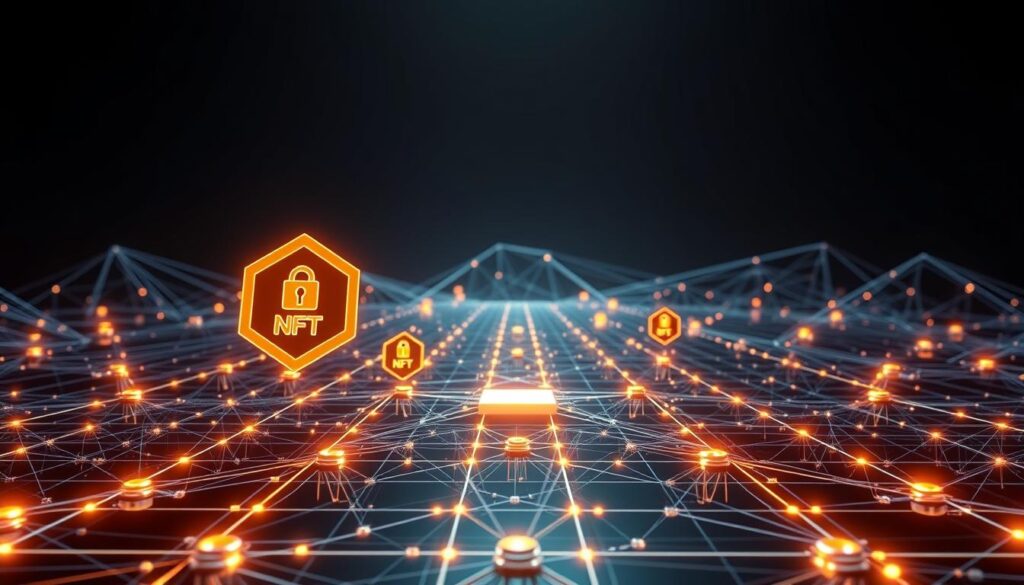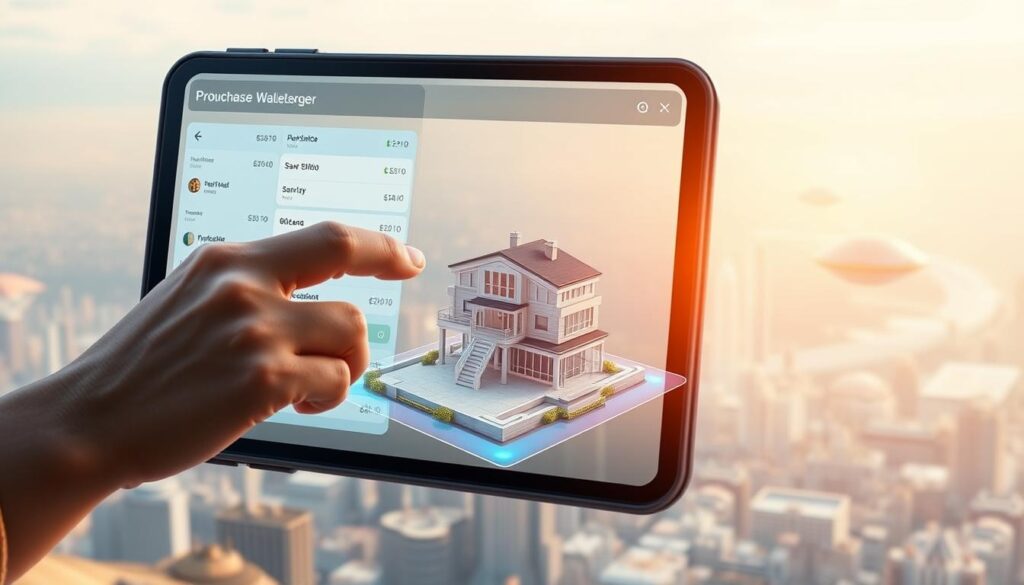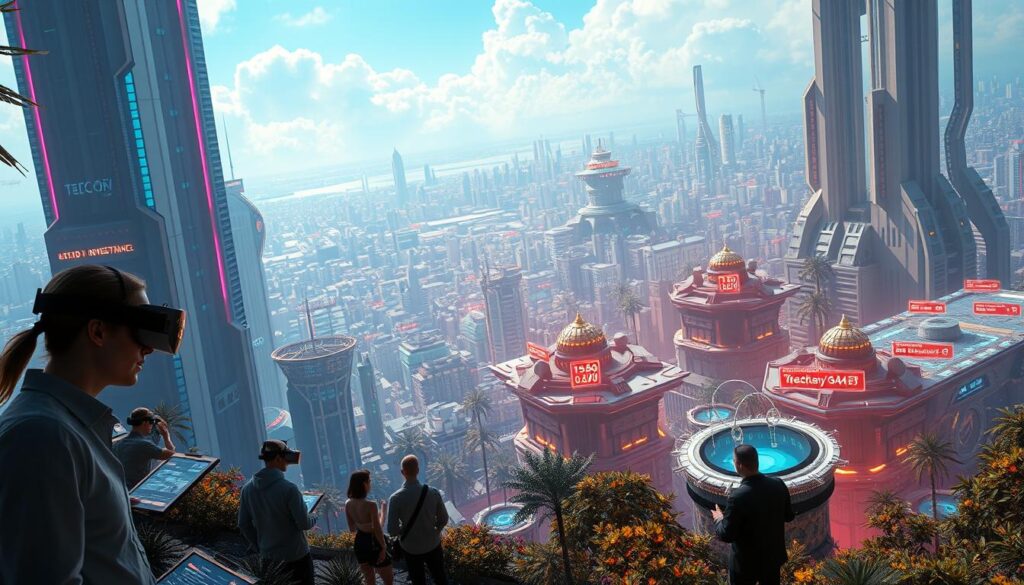Now Reading: Discover the Concept of NFT Metaverse Land Virtual World
- 01
Discover the Concept of NFT Metaverse Land Virtual World
Discover the Concept of NFT Metaverse Land Virtual World

A new digital frontier is emerging, reshaping our understanding of property and ownership. This innovative space allows individuals to acquire parcels of digital territory, authenticated through blockchain technology.
The convergence of virtual reality, augmented reality, and blockchain has created a unique asset class. Investors and enthusiasts can now purchase, develop, and monetise these digital plots. This represents a significant shift in how we perceive value and community.
Major financial investments are flowing into this sector. Recent estimates indicate over $2 billion has been spent on tokens representing these digital properties. Global brands like Nike, McDonald’s, and J.P. Morgan have established notable presences within these platforms.
This comprehensive guide aims to demystify the process of acquiring digital property. We will cover everything from fundamental concepts to step-by-step purchasing instructions. Our goal is to provide you with the practical knowledge to navigate this market confidently.
Values in this space can fluctuate, much like cryptocurrency markets. They are influenced by community activity, platform popularity, and the desirability of a digital location. Understanding these dynamics is crucial for anyone considering an investment.
Key Takeaways
- Digital property ownership is secured using blockchain technology and non-fungible tokens.
- A new asset class has emerged from the blend of virtual reality and blockchain.
- Significant capital, over $2 billion, has been invested in this innovative sector.
- This guide provides a clear path from basic concepts to practical acquisition steps.
- Property values are dynamic, affected by community engagement and platform growth.
- Major corporations are actively establishing themselves in these digital spaces.
Introduction
Contemporary technology is bridging the gap between our physical existence and digital experiences like never before. This convergence creates immersive environments that challenge traditional boundaries.
Setting the Scene for Virtual Innovation
Virtual reality and augmented reality technologies have evolved dramatically. They now create rich, three-dimensional spaces that feel remarkably real.
These innovations blend physical and digital realms seamlessly. Users can interact in ways previously confined to science fiction.
The Rise of the Metaverse
The concept originated in 1992 but gained mainstream attention when Facebook rebranded as Meta. This signalled a major corporate commitment to digital world development.
The metaverse represents a fusion of “meta” and “universe.” It encompasses various digital platforms where users connect through customisable avatars.
Market predictions indicate explosive growth for metaverse real estate, with expansion projected at $11.58 billion by 2028. This demonstrates substantial investor confidence in these new revenue opportunities.
| Platform | Primary Focus | User Base | Real Estate Features |
|---|---|---|---|
| Decentraland | Social & Gaming | 500k+ | Customisable parcels |
| The Sandbox | Creative Experiences | 1M+ | Voxel-based building |
| Somnium Space | VR Immersion | 200k+ | Live persistent worlds |
| Cryptovoxels | Art & Collectibles | 150k+ | Block-based construction |
Each platform offers unique communities and investment strategies. They cater to different interests within the broader digital landscape.
Understanding NFT Metaverse Land Virtual World
The concept of property ownership is evolving beyond physical boundaries into three-dimensional digital spaces. These parcels consist of specific coordinates within interactive environments that users can purchase, develop, and trade as unique assets.
Non-fungible tokens serve as the technological foundation for establishing verifiable ownership. Each digital certificate is unique and cannot be duplicated, providing clear proof of who owns which specific parcel. This system prevents fraud and ensures transparent transaction histories.
Blockchain technology, particularly Ethereum, records every transaction on an immutable public ledger. This creates permanent ownership records that distinguish these assets from interchangeable cryptocurrencies. The technology enables true digital property rights.
Platforms like The Sandbox and Decentraland utilise this infrastructure to create decentralised environments. Users maintain complete control over their digital holdings without centralised oversight. This creates censorship-resistant spaces for creativity and commerce.
The value of these digital properties fluctuates based on several factors. Market demand, platform popularity, and location desirability all influence pricing. Community engagement also plays a crucial role in determining asset worth.
Ownership grants holders full rights to develop, lease, or sell their parcels as they see fit. This creates genuine economic opportunities within these immersive environments. The system mirrors physical property markets while offering new digital possibilities.
Exploring Virtual Real Estate & Digital Property
Property investment opportunities now include digital territories that exist purely in computational space. These assets represent a new frontier for ownership and development.

Defining Virtual Real Estate and Digital Land
Digital real estate consists of parcels within interactive platforms. These spaces function similarly to physical property markets.
Owners can develop residential or commercial structures. They may also create entertainment venues or art galleries. The possibilities for customisation are extensive.
This form of estate ownership provides genuine economic rights. Holders can lease, sell, or develop their holdings freely.
Comparing Virtual and Real-World Property
Virtual property shares several characteristics with physical real estate. Location value and scarcity influence pricing significantly.
Prime digital locations near social hubs command premium values. However, digital holdings require no physical maintenance.
Global accessibility removes geographical barriers. Anyone with cryptocurrency can participate in this market.
The digital real estate sector offers unique advantages. It combines traditional investment principles with technological innovation.
Navigating the Blockchain and NFT Mechanics
To truly grasp the value of digital assets, one must first understand the mechanics of blockchain and the unique properties of NFTs. These technologies work together to solve a fundamental problem of the digital age: proving true ownership of something that can be easily copied.

How NFTs Establish Unique Ownership
Non-fungible tokens are unique digital certificates. Unlike cryptocurrencies, which are interchangeable, each NFT is one-of-a-kind.
This uniqueness is recorded on a blockchain. It creates an immutable record of who owns the asset. When you buy a digital parcel, the NFT becomes your digital deed.
This system provides verifiable scarcity and provenance. It ensures that your ownership is exclusive and can be proven to anyone.
The Role of Blockchain in Authenticating Assets
The blockchain acts as a public, decentralised ledger. It chronologically records every transaction involving an NFT.
This creates a transparent and unalterable history. Anyone can verify the ownership chain, which reduces fraud.
This technology grants owners genuine control. Your rights are secured on the blockchain, independent of any single company or platform.
Steps to Purchase Virtual Land in the Metaverse
Acquiring a digital property parcel involves a clear, step-by-step process centred on security and platform compatibility. This guide outlines the essential actions to take ownership confidently.

Your journey begins with two fundamental preparations. You will need a secure digital storage solution and the correct type of digital currency.
Setting Up a Digital Wallet and Acquiring Cryptocurrency
The first critical step is choosing a digital wallet. This application stores your access keys and the currency needed for your purchase.
Opt for a non-custodial wallet like MetaMask. This type gives you full control over your assets, enhancing security. It connects directly to major platforms.
Next, you must acquire the specific cryptocurrency your chosen platform uses. For example, Decentraland requires MANA, while The Sandbox uses SAND.
Buy this currency on a reputable exchange. Then, transfer it securely to your personal wallet. Always double-check addresses to avoid errors.
Choosing the right wallet is a key security decision. The table below compares common options.
| Wallet Name | Type | Key Feature | Popular Platform Compatibility |
|---|---|---|---|
| MetaMask | Browser & Mobile | Excellent browser integration | The Sandbox, Decentraland |
| Trust Wallet | Mobile | Supports many blockchains | Various platforms |
| Phantom | Browser & Mobile | Optimised for Solana | Solana-based worlds |
Selecting the Right Marketplace and Platform
With your wallet funded, the next step is finding a place to buy. Some platforms have their own dedicated marketplaces.
Decentraland has its own official marketplace. Others use large, third-party sites like OpenSea. Research where the parcels you want are sold.
Browse available properties, check prices, and review location details. Once you find a suitable parcel, you can proceed with the purchase.
The transaction is confirmed on the blockchain. This officially records you as the new owner. Remember to keep your wallet recovery phrase safe at all times.
Investing Opportunities and Revenue Streams
Beyond simple acquisition, digital property offers a spectrum of financial possibilities for investors and entrepreneurs. This asset class supports both long-term growth strategies and active income generation.

Long-Term Investment and Passive Income Potential
Many investors view these digital spaces as the future of social interaction and entertainment. They anticipate significant value appreciation as user bases expand.
Platforms enable owners to lease their holdings to other users. This creates a source of recurring rental income without active management.
Property holders can also develop custom attractions on their parcels. These include galleries, event spaces, or interactive games. They can charge entry fees or earn commissions from sales.
Major corporations like Nike and J.P. Morgan have purchased estates for marketing. Their presence validates the commercial potential of these environments.
Innovative campaigns, like Chipotle’s virtual burrito experience, bridge digital and physical commerce. This demonstrates practical applications for businesses.
Location remains a critical factor for value. Plots near popular hubs or celebrity properties often command higher prices and greater demand.
The most strategic investments can generate multiple revenue streams simultaneously. These combine rental income, event hosting, and capital appreciation.
Risks and Considerations in Virtual Investments
Potential investors must recognise the volatile characteristics of this emerging asset class. Digital property represents one of the most speculative opportunities within cryptocurrency markets.
The speculative nature of these holdings creates significant uncertainty. Platform popularity directly influences property values, creating unpredictable market conditions.
Market Volatility and Speculative Dynamics
Price fluctuations in this space can be extreme. Individual parcels may trade for a few dollars or millions, with values changing rapidly based on community sentiment.
Fundamental valuation remains challenging without established metrics. Investments rely heavily on social trends rather than measurable financial projections.
The table below outlines key risk factors investors should consider:
| Risk Category | Potential Impact | Mitigation Strategy |
|---|---|---|
| Platform Failure | Total investment loss | Diversify across multiple platforms |
| Market Volatility | Rapid price depreciation | Invest only risk capital |
| Regulatory Uncertainty | Limited legal protection | Research jurisdictional frameworks |
| Liquidity Risk | Difficulty selling assets | Focus on established marketplaces |
This investment avenue carries substantial risk due to its nascent nature. Investors should only commit funds they can afford to lose entirely.
Practical Tips for First-Time Buyers
Entering the market for digital properties requires careful preparation and strategic insight. A thoughtful approach can significantly improve your initial experience and protect your investment.
Begin your journey by gathering information from trusted sources. Websites like CoinMarketCap and dAppRadar offer valuable data on popular projects.
Researching Platforms and Communities
Not all digital spaces are created equal. Each one has a unique culture, technical requirements, and economic potential.
Investigate the team behind a project and its long-term roadmap. A strong, active community is often a positive indicator of a platform’s health.
It is crucial to visit these environments yourself. Explore different areas to understand the atmosphere and types of users present.
Attending virtual events is an excellent way to gauge activity levels. This helps you see if a platform aligns with your interests.
Consider the technical side carefully. Some spaces are web-based, while others need powerful computers. This affects who can visit your future property.
If you plan to build, research the necessary tools. For example, developing on one popular platform requires specific software.
Use the table below to compare key research platforms.
| Research Site | Primary Focus | Key Metric Provided |
|---|---|---|
| CoinMarketCap | Cryptocurrency & Token Data | Market Capitalisation, Price Charts |
| CoinGecko | Broad Crypto Analytics | Community Growth, Developer Activity |
| dAppRadar | Decentralised Applications | User Activity, Transaction Volumes |
Safeguarding Your Investment and Managing Digital Assets
Once you decide to purchase, security becomes paramount. Protecting your digital assets is a continuous process.
Start with smaller purchases to understand the market dynamics. This allows you to learn without excessive risk.
For long-term storage, use a hardware wallet. This provides the highest level of security for your digital certificates.
Always enable two-factor authentication on your accounts. Never share your private keys or recovery phrases with anyone.
Consider diversifying your holdings across different platforms. This strategy helps manage risk if one particular space loses popularity.
You can also seek professional advice. Specialised brokers offer guidance on location selection and valuation within these new frontiers.
Conclusion
Digital territories represent more than just speculative assets—they serve as foundations for future communities and economies. With projections indicating 5 billion users by 2030 and market growth exceeding $11 billion, this space offers genuine potential.
The technology behind these assets ensures secure ownership through blockchain verification. Digital wallets and specific cryptocurrencies facilitate transactions, while unique ownership certificates provide clear property rights.
Investors should approach this emerging sector with balanced enthusiasm. While opportunities for appreciation and income exist, market volatility requires careful risk management. Thorough research and community engagement remain essential.
This guide provides the foundational knowledge needed to explore digital property opportunities confidently. The landscape continues to evolve, offering innovative spaces for creativity and connection.
FAQ
What exactly is digital real estate?
Digital real estate refers to parcels of land or property that exist within a virtual environment. These assets are bought and sold, much like physical property, granting the owner certain rights to develop, lease, or sell their virtual space on platforms like Decentraland or The Sandbox.
How does blockchain technology secure my ownership of a virtual property?
Blockchain technology provides a secure, public ledger that records all transactions. When you purchase a plot, the ownership is authenticated and recorded as a unique non-fungible token (NFT) on the blockchain. This creates an immutable and verifiable proof of ownership that cannot be duplicated or forged.
What is the process for buying a parcel of virtual land?
The process typically involves several steps. First, you need to set up a compatible digital wallet, such as MetaMask, and fund it with the necessary cryptocurrency, like Ethereum. Then, you can browse marketplaces like OpenSea to find and purchase a property that suits your investment goals.
Can I generate income from my digital property investment?
Yes, there are several potential revenue streams. Owners can develop their plots to host events, create advertising space, or build virtual shops and experiences to attract visitors. Leasing the space to other users or businesses is another common way to earn passive income.
What are the main risks associated with investing in this space?
The market is highly speculative and can be subject to significant volatility. The value of these assets is heavily influenced by the popularity and user adoption of the specific platform. There is also technological risk, as the long-term viability of individual virtual worlds is not guaranteed.
What should a first-time buyer prioritise before making a purchase?
Thorough research is crucial. Investigate different metaverse platforms to understand their communities, development roadmaps, and economic models. It is also essential to learn how to securely manage your digital wallet and private keys to safeguard your investment from theft or loss.










